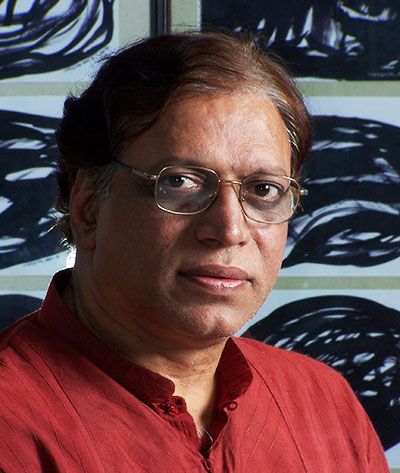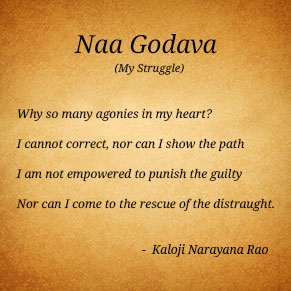We look at some personalities from a range of creative fields, from films to fine arts, literature to music, who have come powerfully to represent the region's culture and aspirations.
FILM: B Narsing Rao

A towering figure in Telugu alternative cinema who was dubbed "the killer of kitsch" for his artistic vision, B Narsing Rao has directed four feature and four documentary films, most of which speak for the oppressed and are strongly tied to the social life of Telangana.
'Daasi' (Bonded Woman), for instance, which was released in 1988 and won five national film awards, describes the life of a young low-caste woman in 1920s Telangana who has been sold by her family to a wealthy upper-caste household. As a bonded servant, she is expected not only to do physical labour but to also be sexually available to the men and guests of the house. She becomes pregnant and wants to keep the child, but her master forces her to have an abortion.
The previous year, Rao released Maa Ooru (My Village), a documentary portraying the static caste-ridden social life in a Telangana village that he had visited when he was five years old. He travelled a total of 6,000 km in the region for the shoot. The film won a national award for the best ethnographic film and another prize at the Hungary International Festival of Visual Arts.
About a decade earlier, Rao had written the screenplay for Maa Bhoomi (Our Land), released in 1979 and directed by Gautam Ghose. Based on a Hindi play, Jab Khet Jaage (When the Fields Awaken), the film tells the story of a landless peasant during the Telangana Rebellion from 1946 to 1951 and shows the immense power of feudal lords, who routinely rounded up villagers and forced them to work for free. The rebellion was primarily an armed peasant revolt against first the region's feudal land owners and then the princely state, but it also helped deepen the region's sense of identity.
"This is a moment I have been waiting for since I became a student leader in 1969, when the agitation for statehood began," he said over the phone from Hyderabad, referring to the passage of the bill enabling the creation of Telangana state.
Rao has been actively involved in generating and disseminating knowledge about the culture of Telangana, contemporary and historical. He is the lead editor of an encyclopaedia on the culture of Telangana, which he expects will be published early next year. He and his co-editors have already commissioned various people to write the encyclopaedia's 200 entries.
Rao is also helping produce a book describing the life and work of 150 post-Independence artists of the region and has already booked a stall at next year's India Art Fair in Delhi that will showcase 42 artists from Telangana.
Already a cultural force in Andhra Pradesh, the multi-faceted Rao, who is also a painter, is likely to play an even more central role in the intellectual life of India's newest state.
Here is his film Maa Bhoomi.
FINE ARTS: Laxma Goud

Source: Dakshinchitra.net.
Like Narsing Rao, Laxma Goud is a native of Medak district. He was fascinated by the region's various crafts, such as those of leather puppetry and terracotta jewellery-making.
He studied art first in Hyderabad and then in Baroda, at the MS University's Faculty of Fine Arts, where he studied mural painting under KG Subramanyan and developed a lifelong love of printmaking.
After graduating, he returned to his village, whose life and mores became the focus of his paintings, particularly the more open sexuality he discerned there. Both his explicitly erotic paintings and those that depicted other aspects of rural life reflected the distinct culture of Telangana.
He himself declined to be interviewed over the phone. "Long-distance conversations don't make a dent," he said. "You should come here and talk to me." But gallery owners in Mumbai who have worked with him said that he was deeply committed to Telangana as a distinct cultural entity, as were many other leading artists from the region, such as Thota Vaikuntam and Laxman Ailay.
"Day-to-day village life is a recurring theme in his work," said Dadiba Pundole, who owns an eponymous gallery in Mumbai and has exhibited Goud's work several times. "Folk culture is very strong in his work, and he draws from the various stories that he heard as a young child."
A Laxma Goud painting.
LITERATURE: Kaloji Narayana Rao

A giant of Telugu letters, Kaloji Narayana Rao, who died in 2002, was both revolutionary and strongly pro-Telangana in his outlook. Born in Warangal district to a Kannadiga mother and a Maharashtrian father, he became fluent in four languages – Telugu, Marathi, Hindi and Urdu, and wrote poetry in all four tongues.
He was just a teenager when he wrote his first poem, which was a response to the colonial government's execution of Bhagat Singh. India's late prime minister, P V Narasimha Rao, was a great admirer of Kaloji Rao, who received the Padma Vibhushan in 1992.
"He is a huge literary figure," said Nandini Siddha Reddy, the founder-president of the Telangana Writers' Forum, a poet, songwriter and editor of the now defunct quarterly, Soyee, which means "consciousness" in the Telangana dialect of Telugu. "His Naa Godava (My Struggle), written in the early 1950s, is a monumental work in verse about Telangana society. Had he been alive today, he would have been very happy to see Telangana become a state. We have all struggled for six decades to see this day. Our writers are all immensely happy."

From Naa Godava.
MUSIC: Gaddar

Born as Gummadi Vittal Rao to a poor Dalit family in Medak district, of which Narsing Rao is also a native, Gaddar adopted the one-word name by which he became popularly known, as a tribute to the Ghadar Party, which fought against British colonial rule in Punjab.
In his late teens, Gaddar became involved in social activism and street theatre. In 1969, he, like Narsing Rao, joined the Separate Telangana Agitation, eventually joining the filmmaker's Art Lovers' Association and attending its weekly gatherings. Through these meetings, Gaddar imbibed the social critiques of the Communist Party of India (Marxist-Leninist), which Rao was close to.
Rao encouraged Gaddar, asking him to write his first song, Apuro Autorickshaw (Stop Rickshaw), through which he urged the singer to highlight their harsh working life. This song became a massive hit, especially among the working classes and helped him flower into a full-fledged singer-songwriter.
Gaddar remained closely associated with the filmmaker, writing songs for two of his films and touring with him in the 1970s as part of the street theatre group Jana Natya Mandali. These songs influenced people across Telangana, both those who were left-oriented and those who were just nationalists. Amma Telanganama combined both these ideologies.
The movement for statehood spawned a number of balladeers, such as Gorati Venkanna and Ande Sri, the latter who has written a version of Telangana's national anthem, called Jai Jai He Telangana. Many songs were local folk songs that Gaddar and his confrères adapted to their political ends.
Today, as one of Telangana's most well-known balladeers, Gaddar welcomed the formation of Telangana but says the bigger battle for social justice remains to be fought.
"Of course, I welcome the new geographical entity," he said over the phone, "because small states benefit small people.But the people's Telangana has yet to become a reality. As long as society is economically unequal, our struggle will continue. What we want are jungle, jameen and jal" – forest, land and water.
Gaddar's 'Podustunna Poddumeeda' (Breaking dawn) from the movie Jai Bolo Telangana, directed by N Shankar, about the region's history and struggle for statehood.
HANDICRAFT: Pochampally ikat weave

Girl standing in a veranda wearing a Pochampally Ikat weave sari, by Hermann Linde (1863-1923).
Famous for its hand-woven sarees that take its name, this region in Telangana's Nalgonda district consists of about 75 villages. The sarees, and other fabrics, usually have intricate geometric designs. The style of weaving is part of the larger Ikat tradition, which extends to parts of Orissa and in which craftsmen use traditional looms to produce cotton and silk weaves.
The Pochampally weave is among the more well-known of Telangana's myriad crafts, which include the Nakashi scroll paintings typical of the Cheriyal region and leather puppetry, to name just two.

A Cherial scroll painting in progress.
FESTIVALS: Bathukamma

Batukamma festival at Rajalingampet
This is a flower festival unique to Telangana and is not celebrated in other parts of Andhra Pradesh. It is celebrated by Hindu women, lasts for nine days and roughly coincides with Navratri, ending one day before Dussehra.











